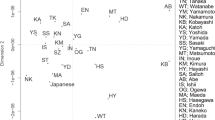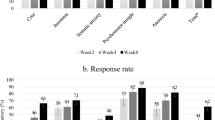Abstract
In men, follicle-stimulating hormone (FSH) acts on the seminiferous tubules and enhances spermatogenesis. Recently, a candidate locus (rs2414095) for FSH levels was identified by a genome-wide association study (GWAS) in Chinese men. The rs2414095 single-nucleotide polymorphism (SNP) is found on the third intron of the cytochrome P450, family 19, subfamily A, peptide 1 (CYP19A1) gene encoding an aromatase. In the present study, we performed a replication study in 1687 Japanese men (901 from cohort 1 and 786 from cohort 2) to assess whether this SNP is associated with circulating FSH levels. Furthermore, we investigated whether the rs2414095 SNP is correlated with semen quality traits in 2015 Japanese men (1224 from cohort 1 and 791 from cohort 2). The rs2414095 SNP was significantly associated with circulating FSH levels (βSTD=0.15, P=9.7 × 10-5), sperm concentration (βSTD=0.073, P=0.032) and total sperm number (TSN) (βSTD=0.074, P=0.027) in a combined analysis of the two Japanese male cohorts. We successfully replicated, in Japanese men, the results of the previous GWAS for the rs2414095 SNP in Chinese men, and found that the rs2414095 SNP was related with sperm production.
Similar content being viewed by others
Log in or create a free account to read this content
Gain free access to this article, as well as selected content from this journal and more on nature.com
or
References
Belchetz, P. E., Plant, T. M., Nakai, E. J. & Knobil, E. Hypophysial responses to continuous and intermittent delivery of hypopthalamic gonadotropin-releasing hormone. Science 202, 631–633 (1978).
Smith, M. A. & Vale, W. W. Desensitization to gonadotropin-releasing hormone observed in superfused pituitary cells on Cytodex beads. Endocrinology 108, 752–759 (1981).
Kaufman, J. M. & Vermeulen, A. The decline of androgen levels in elderly men and its clinical and therapeutic implications. Endocr. Rev. 26, 833–876 (2005).
Raivio, T., Toppari, J., Perheentupa, A., McNeilly, A. S. & Dunkel, L. Treatment of prepubertal gonadotrophin-deficient boys with recombinant human follicle-stimulating hormone. Lancet 350, 263–264 (1997).
Bonn, D. Male contraceptive research steps back into spotlight. Lancet 353, 302 (1999).
Amory, J. K. Progress and prospects in male hormonal contraception. Curr. Opin. Endocrinol. Diabetes Obes. 15, 255–260 (2008).
Ring, H. Z., Lessov, C. N., Reed, T., Marcus, R., Holloway, L., Swan, G. E. et al. Heritability of plasma sex hormones and hormone binding globulin in adult male twins. J. Clin. Endocrinol. Metab. 90, 3653–3658 (2005).
Kuijper, E. A., Lambalk, C. B., Boomsma, D. I., van der Sluis, S., Blankenstein, M. A., de Geus, E. J. et al. Heritability of reproductive hormones in adult male twins. Hum. Reprod. 22, 2153–2159 (2007).
Chen, Z., Tao, S., Gao, Y., Zhang, J., Hu, Y., Mo, L. et al. Genome-wide association study of sex hormones, gonadotropins and sex hormone-binding protein in Chinese men. J. Med. Genet. 50, 794–801 (2013).
Nakahori, Y., Sato, Y., Ewis, A. A., Iwamoto, T., Shinka, T., Nozawa, S. et al. Climatic influence on the reproductive characteristics of Japanese males. J. Hum. Genet. 57, 375–378 (2012).
Iwamoto, T., Nozawa, S., Yoshiike, M., Namiki, M., Koh, E., Kanaya, J. et al. Semen quality of fertile Japanese men: a cross-sectional population-based study of 792 men. BMJ Open 3, e002223 (2013).
Iwamoto, T., Nozawa, S., Mieno, M. N., Yamakawa, K., Baba, K., Yoshiike, M. et al. Semen quality of 1559 young men from four cities in Japan: a cross-sectional population-based study. BMJ Open 3, e002222 (2013).
Sato, Y., Shinka, T., Iwamoto, T., Yamauchi, A. & Nakahori, Y. Y chromosome haplogroup D2* lineage is associated with azoospermia in Japanese males. Biol. Reprod. 88, 107 (2013a).
Sato, Y., Jinam, T., Iwamoto, T., Yamauchi, A., Imoto, I., Inoue, I. et al. Replication study and meta-analysis of human non-obstructive azoospermia in Japanese populations. Biol. Reprod. 88, 87 (2013b).
Sato, Y., Iwamoto, T., Shinka, T., Nozawa, S., Yoshiike, M., Koh, E. et al. Y chromosome gr/gr subdeletion is associated with lower semen quality in young men from the general Japanese population but not in fertile Japanese men. Biol. Reprod. 90, 116 (2014a).
Sato, Y., Shinka, T., Ewis, A. A., Yamauchi, A., Iwamoto, T. & Nakahori, Y. Overview of genetic variation in the Y chromosome of modern Japanese males. Anthropol. Sci. 122, 131–136 (2014b).
Sato, Y., Shinka, T., Nozawa, S., Yoshiike, M., Koh, E., Kanaya, J. et al. Y chromosome haplogroup D2a1 is significantly associated with high levels of luteinizing hormone in Japanese men. Andrology 3, 520–525 (2015a).
Sato, Y., Tajima, A., Tsunematsu, K., Nozawa, S., Yoshiike, M., Koh, E. et al. Lack of replication of four candidate SNPs implicated in human male fertility traits: a large-scale population-based study. Hum. Reprod. 30, 1505–1509 (2015b).
Sato, Y., Tajima, A., Tsunematsu, K., Nozawa, S., Yoshiike, M., Koh, E. et al. An association study of four candidate loci for human male fertility traits with male infertility. Hum. Reprod. 30, 1510–1514 (2015c).
Vermeulen, A., Verdonck, L. & Kaufman, J. M. A critical evaluation of simple methods for the estimation of free testosterone in serum. J. Clin. Endocrinol. Metab. 84, 3666–3672 (1999).
World Health Organization.WHO Laboratory Manual for the Examination of Human Semen and Sperm-cervical Mucus Interaction. 4th edn (Cambridge University Press, Cambridge, UK, 1999).
Higgins, J. P, Thompson, S. G., Deeks, J. J. & Altman, D. G. Measuring inconsistency in meta-analyses. BMJ 327, 557–560 (2003).
Hillier, S. G., Whitelaw, P. F. & Smyth, C. D. Follicular oestrogen synthesis: the 'two-cell, two-gonadotrophin' model revisited. Mol. Cell Endocrinol. 100, 51–54 (1994).
Smyth, C. D., Miro, F., Howles, C. M. & Hillier, S. G. Effect of luteinizing hormone on follicle-stimulating hormone-activated paracrine signaling in rat ovary. Hum. Reprod. 1, 33–39 (1995).
Thompson, E. A. Jr & Siiteri, P. K. Utilization of oxygen and reduced nicotinamide adenine dinucleotide phosphate by human placental microsomes during aromatization of androstenedione. J. Biol. Chem. 249, 5364–5372 (1974).
Morishima, A., Grumbach, M. M., Simpson, E. R., Fisher, C. & Qin, K. Aromatase deficiency in male and female siblings caused by a novel mutation and the physiological role of estrogens. J. Clin. Endocrinol. Metab. 80, 3689–3698 (1995).
Zhao, D., Pan, L., Zhang, F., Pan, F., Ma, J., Zhang, X. et al. Successful use of aromatase inhibitor letrozole in NOA with an elevated FSH level: a case report. Andrologia 46, 456–457 (2014).
Bighin, C., Lunardi, G., Del Mastro, L., Marroni, P., Taveggia, P., Levaggi, A. et al. Estrone sulphate, FSH, and testosterone levels in two male breast cancer patients treated with aromatase inhibitors. Oncologist 15, 1270–1272 (2010).
Wickman, S., Sipilä, I., Ankarberg-Lindgren, C., Norjavaara, E. & Dunkel, L. A specific aromatase inhibitor and potential increase in adult height in boys with delayed puberty: a randomised controlled trial. Lancet 357, 1743–1748 (2001).
Harada, N., Ogawa, H., Shozu, M., Yamada, K., Suhara, K., Nishida, E. et al. Biochemical and molecular genetic analyses on placental aromatase (P-450AROM) deficiency. J. Biol. Chem. 267, 4781–4785 (1992).
Ito, Y., Fisher, C. R., Conte, F. A., Grumbach, M. M. & Simpson, E. R. Molecular basis of aromatase deficiency in an adult female with sexual infantilism and polycystic ovaries. Proc. Natl Acad. Sci. USA 90, 11673–11677 (1993).
Morishima, A., Grumbach, M. M., Simpson, E. R., Fisher, C. & Qin, K. Aromatase deficiency in male and female siblings caused by a novel mutation and the physiological role of estrogens. J. Clin. Endocrinol. Metab. 80, 3689–3698 (1995).
Hauri-Hohl, A., Meyer-Böni, M., Lang-Muritano, M., Hauri-Hohl, M., Schoenle, E. J. & Biason-Lauber, A. Aromatase deficiency owing to a functional variant in the placenta promoter and a novel missense mutation in the CYP19A1 gene. Clin. Endocrinol. (Oxf) 75, 39–43 (2011).
Bouchoucha, N., Samara-Boustani, D., Pandey, A. V., Bony-Trifunovic, H., Hofer, G., Aigrain, Y. et al. Characterization of a novel CYP19A1 (aromatase) R192H mutation causing virilization of a 46,XX newborn, undervirilization of the 46,XY brother, but no virilization of the mother during pregnancies. Mol. Cell. Endocrinol. 390, 8–17 (2014).
Marino, R., Perez Garrido, N., Costanzo, M., Guercio, G., Juanes, M., Rocco, C. et al. Five new cases of 46,XX aromatase deficiency: clinical follow-up from birth to puberty, a novel mutation, and a founder effect. J. Clin. Endocrinol. Metab. 100, E301–E307 (2015).
Harada, N., Ogawa, H., Shozu, M. & Yamada, K. Genetic studies to characterize the origin of the mutation in placental aromatase deficiency. Am. J. Hum. Genet. 51, 666–672 (1992).
Herrmann, B. L., Saller, B., Janssen, O. E., Gocke, P., Bockisch, A., Sperling, H. et al. Impact of estrogen replacement therapy in a male with congenital aromatase deficiency caused by a novel mutation in the CYP19 gene. J. Clin. Endocrinol. Metab. 87, 5476–5484 (2002).
Conte, F. A., Grumbach, M. M., Ito, Y., Fisher, C. R. & Simpson, E. R. A syndrome of female pseudohermaphrodism, hypergonadotropic hypogonadism, and multicystic ovaries associated with missense mutations in the gene encoding aromatase (P450arom). J. Clin. Endocrinol. Metab. 78, 1287–1292 (1994).
Mullis, P. E., Yoshimura, N., Kuhlmann, B., Lippuner, K., Jaeger, P. & Harada, H. Aromatase deficiency in a female who is compound heterozygote for two new point mutations in the P450arom gene: impact of estrogens on hypergonadotropic hypogonadism, multicystic ovaries, and bone densitometry in childhood. J. Clin. Endocrinol. Metab. 82, 1739–1745 (1997).
Carani, C., Qin, K., Simoni, M., Faustini-Fustini, M., Serpente, S., Boyd, J. et al. Effect of testosterone and estradiol in a man with aromatase deficiency. N. Engl. J. Med. 337, 91–95 (1997).
Belgorosky, A., Pepe, C., Marino, R., Guercio, G., Saraco, N., Vaiani, E. et al. Hypothalamic-pituitary-ovarian axis during infancy, early and late prepuberty in an aromatase-deficient girl who is a compound heterocygote for two new point mutations of the CYP19 gene. J. Clin. Endocrinol. Metab. 88, 5127–5131 (2003).
Schlatt, S. & Ehmcke, J. Regulation of spermatogenesis: an evolutionary biologist's perspective. Semin. Cell Dev. Biol. 29, 2–16 (2014).
Acknowledgements
We thank all the volunteers who participated in this study. We are grateful to the late Professor Yutaka Nakahori for collecting blood samples from the participants. We also thank Professor Toyomasa Katagiri for his assistance with the AB GeneAmp PCR system 9700. This study was supported in part by the Ministry of Health and Welfare of Japan (1013201) (to TI), Grant-in-Aids for Scientific Research (C) (26462461) (to YS) and (23510242) (to ATa), Grant-in-Aids for Scientific Research (B) (15H04320) (to ATa) from the Japan Society for the Promotion of Science, the European Union (BMH4-CT96-0314) (to TI), the Takeda Science Foundation (to ATa) and a research program for the development of intelligent Tokushima artificial Exosome (iTEX) from Tokushima University.
Author information
Authors and Affiliations
Corresponding authors
Ethics declarations
Competing interests
The authors declare no conflict of interest.
Additional information
Supplementary Information accompanies the paper on Journal of Human Genetics website
Supplementary information
Rights and permissions
About this article
Cite this article
Sato, Y., Tajima, A., Katsurayama, M. et al. A replication study of a candidate locus for follicle-stimulating hormone levels and association analysis for semen quality traits in Japanese men. J Hum Genet 61, 911–915 (2016). https://doi.org/10.1038/jhg.2016.82
Received:
Revised:
Accepted:
Published:
Issue date:
DOI: https://doi.org/10.1038/jhg.2016.82
This article is cited by
-
Association of TUSC1 and DPF3 gene polymorphisms with male infertility
Journal of Assisted Reproduction and Genetics (2018)



